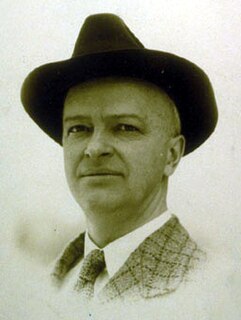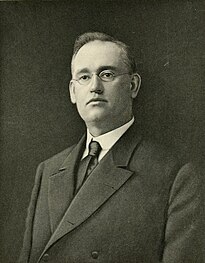Sterilization is any of a number of medical methods of birth control that intentionally leaves a person unable to reproduce. Sterilization methods include both surgical and non-surgical, and exist for both males and females. Sterilization procedures are intended to be permanent; reversal is generally difficult or impossible.
The Eugenics Board of North Carolina (EBNC) was a State Board of the state of North Carolina formed in July 1933 by the North Carolina State Legislature by the passage of House Bill 1013, entitled 'An Act to Amend Chapter 34 of the Public Laws of 1929 of North Carolina Relating to the Sterilization of Persons Mentally Defective'. This Bill formally repealed a 1929 law, which had been ruled as unconstitutional by the North Carolina Supreme Court earlier in the year.
Buck v. Bell, 274 U.S. 200 (1927), is a decision of the United States Supreme Court, written by Justice Oliver Wendell Holmes, Jr., in which the Court ruled that a state statute permitting compulsory sterilization of the unfit, including the intellectually disabled, "for the protection and health of the state" did not violate the Due Process Clause of the Fourteenth Amendment to the United States Constitution. Despite the changing attitudes in the coming decades regarding sterilization, the Supreme Court has never expressly overturned Buck v. Bell. It was widely believed to have been slightly weakened by Skinner v. Oklahoma 316 U.S. 535 (1942), which involved compulsory sterilization of male habitual criminals. The Americans with Disabilities Act of 1990 has also made guaranteed protections from the federal government to people with disabilities, including the intellectually disabled.
Skinner v. State of Oklahoma, ex rel. Williamson, 316 U.S. 535 (1942), was the United States Supreme Court ruling that held that laws permitting the compulsory sterilization of criminals are unconstitutional as it violates a person's rights given under the 14th Amendment of the United States Constitution, specifically the Equal Protection Clause, as well as the Due Process Clause. The relevant Oklahoma law applied to "habitual criminals", but the law excluded white-collar crimes from carrying sterilization penalties.
Compulsory sterilization, also known as forced or coerced sterilization, is a government-mandated program to involuntarily sterilize a specific group of people. Compulsory sterilization removes a person's capacity to reproduce, usually through surgical procedures. Several countries implemented sterilization programs in the early 20th century. Although such programs have been made illegal in most countries of the world, instances of forced or coerced sterilizations persist.
The term feeble-minded was used from the late 19th century in Europe, the United States and Australasia for disorders later referred to as illnesses or deficiencies of the mind.

Carrie Elizabeth Buck was the plaintiff in the United States Supreme Court case Buck v. Bell, after having been ordered to undergo compulsory sterilization for purportedly being "feeble-minded" by her foster parents after their nephew raped and impregnated her. She had given birth to an illegitimate child without the means to support it. The surgery, carried out while Buck was an inmate of the Virginia State Colony for Epileptics and Feebleminded, took place under the authority of the Sterilization Act of 1924, part of the Commonwealth of Virginia's eugenics program.

In 1924, the Virginia General Assembly enacted the Racial Integrity Act. The act reinforced racial segregation by prohibiting interracial marriage and classifying as "white" a person "who has no trace whatsoever of any blood other than Caucasian." The act, an outgrowth of eugenist and scientific racist propaganda, was pushed by Walter Plecker, a white supremacist and eugenist who held the post of registrar of Virginia Bureau of Vital Statistics.

Harry Hamilton Laughlin was an American educator and eugenicist. He served as the superintendent of the Eugenics Record Office from its inception in 1910 to its closing in 1939, and was among the most active individuals in influencing American eugenics policy, especially compulsory sterilization legislation.

Joseph Spencer DeJarnette was the director of Western State Hospital from 1905 to November 15, 1943. He was a vocal proponent of racial segregation and eugenics, specifically, the compulsory sterilization of the mentally ill.
In 1928, the Legislative Assembly of Alberta, Canada, enacted the Sexual Sterilization Act. The Act, drafted to protect the gene pool, allowed for sterilization of mentally disabled people in order to prevent the transmission of traits to offspring deemed undesirable.

Nazi eugenics refers to the social policies of eugenics in Nazi Germany. The racial ideology of Nazism placed the biological improvement of the German people by selective breeding of "Nordic" or "Aryan" traits at its center.
Compulsory sterilization in Canada has a documented history in the provinces of Alberta, Saskatchewan, and British Columbia. In 2017, sixty indigenous women in Saskatchewan sued the provincial government, claiming they had been forced to accept sterilization before seeing their newborn babies.

Eugenics, the set of beliefs and practices which aims at improving the genetic quality of the human population, played a significant role in the history and culture of the United States from the late 19th century into the mid-20th century. The cause became increasingly promoted by intellectuals of the Progressive Era.
Institutions for Defective Delinquents (IDDs) were created in the United States as a result of the eugenic criminology movement. The practices in these IDDs contain many traces of the eugenics that were first proposed by Sir Francis Galton in the late 1800s. Galton believed that "our understanding of the laws of heredity [could be used] to improve the stock of humankind." Galton eventually expanded on these ideas to suggest that individuals deemed inferior, those in prisons or asylums and those with hereditary diseases, would be discouraged from having children.
In the 1960s and 1970s, the Indian Health Service (IHS) and collaborating physicians sustained a practice of performing sterilizations on Native American women, in many cases without the informed consent of their patients. In some cases, women were misled into believing that the sterilization procedure was reversible. In other cases, sterilization was performed without the adequate understanding and consent of the patient, including cases in which the procedure was performed on minors as young as 11 years old. A compounding factor was the tendency of doctors to recommend sterilization to poor and minority women in cases where they would not have done so to a wealthier white patient. Other cases of abuse have been documented as well, including when health providers did not tell women they were going to be sterilized, or other forms of coercion including threatening to take away their welfare or healthcare.

The Virginia Sterilization Act of 1924 was a U.S. state law which greatly influenced the development of eugenics in the twentieth century. The act was based on model legislation written by Harry H. Laughlin and challenged by a case that led to the United States Supreme Court decision of Buck v. Bell. The Supreme Court upheld the law; consequentially, proving that it was constitutional and making it a model law for sterilization laws in other states. Justice Holmes wrote that a patient may be sterilized "on complying with the very careful provisions by which the act protects the patients from possible abuse." Between 1924 and 1979, Virginia sterilized over 7,000 individuals under the act. The act was never declared unconstitutional; however, in 2001, the Virginia General Assembly passed a joint resolution apologizing for the misuse of "a respectable, 'scientific' veneer to cover activities of those who held blatantly racist views." In 2015, the Assembly agreed to compensate individuals sterilized under the act.
Sterilization law is the area of law, within reproductive rights, that gives a person the right to choose or refuse reproductive sterilization and governs when the government may limit this fundamental right. Sterilization law includes federal and state constitutional law, statutory law, administrative law, and common law. This article primarily focuses on laws concerning compulsory sterilization that have not been repealed or abrogated and are still good laws, in whole or in part, in each jurisdiction.
The Relf Sisters, Minnie Lee and Mary Alice Relf, are two African-American sisters who were involuntarily sterilized by tubal ligation by a federally funded family planning clinic in Montgomery, Alabama in 1973. News coverage of a class-action lawsuit filed by the Southern Poverty Law Center brought the fact of U.S. government-funded sterilization abuse to the national spotlight.
Sterilization of Latinas has been practiced in the United States on women of different Latin American identities, including those from Puerto Rico and Mexico. There is a significant history of such sterilization practices being conducted involuntarily, in a coerced or forced manner, as well as in more subtle forms such as that of constrained choice. Forced sterilization was permissible by multiple states throughout various periods in the 20th century. Issues of state sterilization have persisted as recently as September 2020. Some sources credit the practice to theories of racial eugenics.






